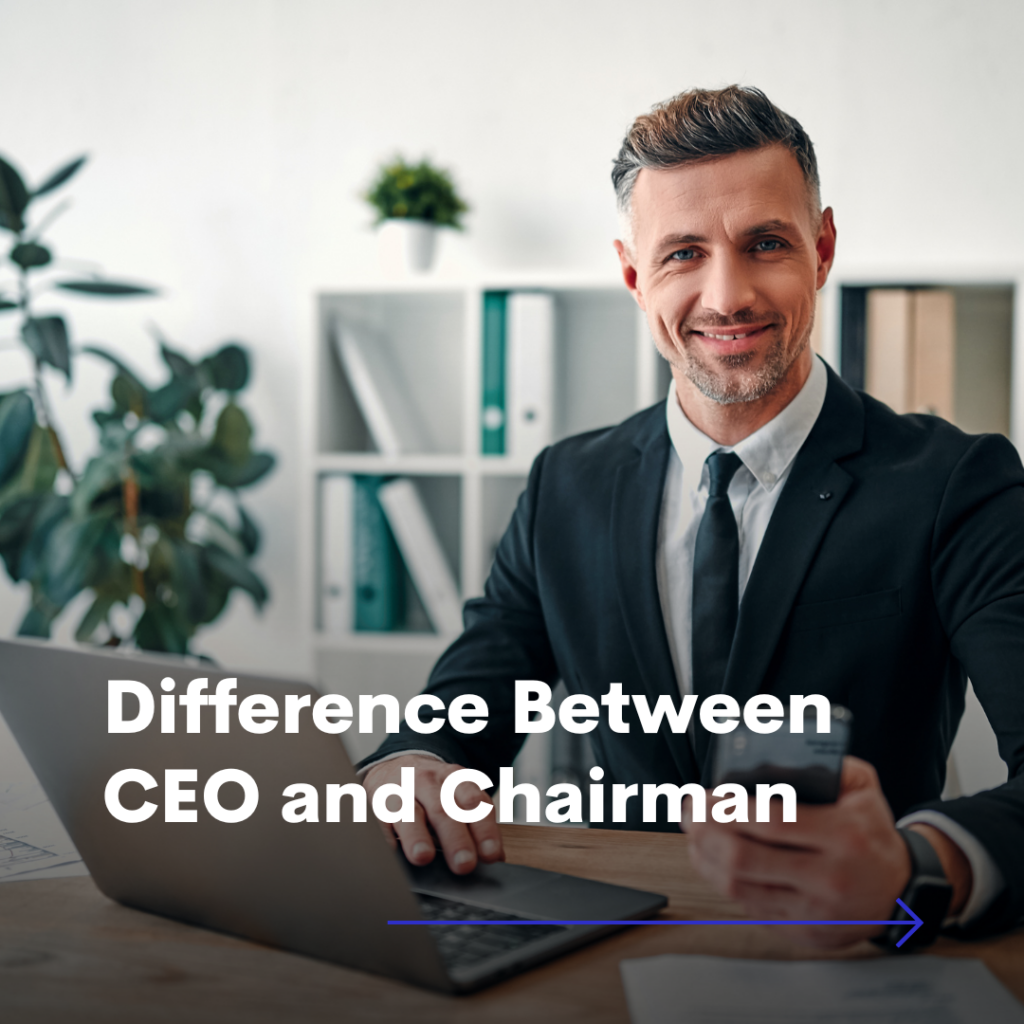Difference Between CEO and Chairman

Perhaps you are already familiar with Microsoft’s Bill Gates and Steve Ballmer. You have likely assumed that Gates is the CEO of the massive corporation and that Ballmer is his right-hand man. In actuality and to be more precise, Bill Gates serves as Microsoft’s chairman and Steve Ballmer as its chief executive officer.
Also Read: –Difference Between Cute and Hot
People frequently believe that the Chief Executive Officer, or CEO, is the highest position within a firm. Well, it is true that many CEOs are the owners or top dogs of their respective firms. However, this does not imply that CEO positions are always held by company owners or that the positions are of the highest rank.
Bill Gates, and not Steve Ballmer, is at the top of the Microsoft pyramid; to believe otherwise would be to place Bill Gates underneath Steve Ballmer. However, this merely indicates that being Chairman is unquestionably more prestigious than being CEO.
It is highly typical for individuals to believe that CEOs are the company’s leaders because they are frequently observed delegating and performing other administrative tasks. They have control over all employees, agents, officers, and executives. Essentially, the CEO is in charge of the entire operation and function of the company.
CEOs focus on strategic issues in accordance with the mission and objectives of the organisation. The CEO is the ship’s captain, yet he or she is accountable to the Board of Directors and the Chairman of the firm.
The performance of the CEO is eventually reviewed by the board of directors, depending mostly on the success or failure of the company. Even while the primary strategies and execution of crucial procedures may appear to be the ultimate say of CEOs, they cannot proceed with a particular method in critical conditions without Board approval.
It also states that the Board can reverse the CEO’s decisions. The work of the CEO is highly dependent on the Board’s pleasure, which is led by the Chairman. Therefore, the Chairman is technically superior to the CEO.
The Board safeguards the investors’ best interests in terms of the company’s profitability and stability, and the CEO will execute the agenda agreed by the Chairman and board. CEOs typically offer strategic plans, which must be approved by the chairman and board.
It should be emphasised, however, that there is a balance of power between the Chairman and CEO, as the CEO has the authority to nominate top executives who, in turn, are guaranteed board seats. It is not uncommon for a company’s chairman to also serve as its chief executive officer.
What is the Difference in Duties Between the CEO & the Chairman of the Board?
There are substantial distinctions between the roles and obligations of the CEO and the board chair. The CEO is the chief executive officer over management, whereas the board chairperson is the head of the board of directors.
The CEO is the company’s main decision-maker and is responsible for daily operations and logistics. All senior management executives report to the chief executive officer. Depending on the size of the organisation, the CEO typically allocates a number of responsibilities to other senior, mid-level, and lower-level managers.
In contrast, the executive chairman of a firm serves as the board’s chairman. The shareholders elect the board of directors, which looks out for the best interests of the investors. This job includes guaranteeing the company’s profitability and stability. Boards often convene quarterly to formulate long-term objectives, consider committee reports, including those from the executive committee, evaluate and monitor financial reports, supervise senior-level executives, and vote on significant decisions.
In addition to recruiting, hiring, and reviewing the CEO’s performance, board directors are accountable for dismissing individuals who do not fulfil performance objectives.
Every organisation has a management team to ensure that everything goes according to plan. Public corporations are required to have a Board of Directors chaired by a Chairman. Additionally, most businesses have a Chief Executive Officer (or CEO). In many instances, the same person plays both roles. But what do these various titles actually mean?
The Chairman reviews the company’s performance, while the CEO manages the company. Their roles can vary from company to company, but some things remain constant. Here are some of the most significant distinctions between these roles:
What are a CEO’s functions and responsibilities?
The chief executive officer (CEO) is the highest-ranking employee and decision-maker who is accountable for daily choices. Creating a strategic strategy for the company’s performance is required. They must make frequent decisions, such as which markets to enter and how to compete with the competitors.
The chief executive officer is accountable for coordinating the senior management team. They manage the performance of this team and delegate responsibilities. It is the role of the CEO to motivate their employees and establish a solid business culture. They establish departmental budgets for the year and have a comprehensive awareness of the organisation’s structure.
The activities of the CEO account for around 45 percent of a company’s performance! This demonstrates the importance of aligning their ambitions with those of the firm. However, the CEO cannot simply do as they please. They are answerable to the Board of Directors and, by extension, to the Chairman of the Board.
What are a Chairman’s roles and responsibilities?
The company’s Chairman supervises the Board of Directors. The shareholders elect them to maintain an overall corporate plan and create long-term objectives. The Chairman does not have ultimate influence over the Board, but they are a highly powerful force. They have the ability to determine the agenda for meetings and affect the outcome of votes.
As with the rest of the Board, their function involves less day-to-day company management. Instead, they focus on the outcomes of these day-to-day acts and whether or not the organisation is fulfilling its promise. They must consider the company’s CSR objectives and ESG concerns, as well as its interactions with external investors.
The Board is also responsible for evaluating the CEO to ensure that their activities align with the organisation’s objectives. Typically, this is determined by profitability and financial performance. However, not all productive businesses are always profitable. The Chairman may need to evaluate additional criteria, such as stability and recovery following a difficult financial time.
If the CEO fails to meet expectations, the Chairman will organise a replacement alongside the Board.
How do these positions differ amongst businesses?
The authority of these positions varies widely amongst companies. It depends on the company’s culture and the Chairman’s desired function. There are two primary varieties of Chairman: executive and non-executive. An executive Chairman is an employee of the company, whereas a non-executive Chairman is not, albeit having some similar obligations. A non-executive Chairman’s responsibility is to manage the board while maintaining a distance from the corporation.
In contrast, an executive Chairman has other responsibilities and plays a more active part in the company’s operations. They may be a former CEO who wishes to aid the company’s advancement. Robert Iger served as CEO of The Walt Disney Company until 2020, when he assumed the position of Executive Chairman. To support the transition, Iger remained Executive Chairman for a year after Bob Chapek was appointed CEO.
Regardless of the situation, the best Chairman-CEO relationships involve cooperation. This indicates that they are working towards the same objectives and have a comparable understanding of the approaches that should be employed. It is crucial that the CEO and Chairman communicate well.
Can one individual hold the positions of CEO and Chairman?
It is entirely conceivable for a single individual to serve as both Chairman and CEO! In fact, there are numerous notable examples, such as Jeff Bezos and Mark Zuckerberg. According to CEO World Magazine, JPMorgan Chase & Co.’s Jamie Dimon was the most influential CEO in the world last year. Four of the top 10 CEOs on their list are both the Chairman and the CEO.
Having a joint Chairman and Chief Executive Officer helps streamline the decision-making process and clarify the company’s culture. Particularly in smaller businesses, a skilled and passionate individual might alter the business’s fate.
There are disadvantages to having a shared responsibility. This indicates that the CEO will discuss and vote on their own performance. As the board votes on the compensation of senior management, a Chairman who is also the chief executive officer would vote on their own compensation. Governance watchdogs have advocated for a stronger separation between the board of directors and top management.
The connection between the Chairman and CEO will ultimately rely on the company. Every board has its own set of priorities and objectives. The CEO and Chairman should constantly prioritise effective communication. A board portal such as Convene will facilitate these partnerships. Using intelligent features like shared annotations, fast voting, and action items, you can ensure that your CEO and Chairman are on the same page, even if they are not the same person.







